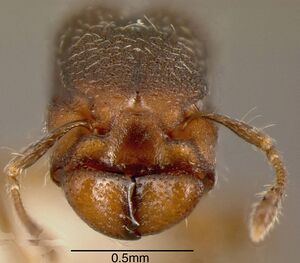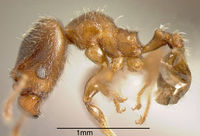Pheidole truncula
| Pheidole truncula | |
|---|---|

| |
| Scientific classification | |
| Kingdom: | Animalia |
| Phylum: | Arthropoda |
| Class: | Insecta |
| Order: | Hymenoptera |
| Family: | Formicidae |
| Subfamily: | Myrmicinae |
| Tribe: | Attini |
| Genus: | Pheidole |
| Species: | P. truncula |
| Binomial name | |
| Pheidole truncula Wilson, 2003 | |
Occurs at Penas Blancas in wet forest and nests at least in part arboreally, apparently in live plant stems (Longino 1997). On one occasion workers were mixed with those of the rare army-ant-like ponerine Simopelta, making it likely that the truncula were under attack as prey at the moment of collection. (Wilson 2003)
Identification
See the description in the nomenclature section.
Keys including this Species
Distribution
Known only from several collections from the type locality. (Wilson 2003)
Latitudinal Distribution Pattern
Latitudinal Range: 10.33333° to 10.33333°.
| North Temperate |
North Subtropical |
Tropical | South Subtropical |
South Temperate |
- Source: AntMaps
Distribution based on Regional Taxon Lists
Neotropical Region: Costa Rica (type locality).
Distribution based on AntMaps
Distribution based on AntWeb specimens
Check data from AntWeb
Countries Occupied
| Number of countries occupied by this species based on AntWiki Regional Taxon Lists. In general, fewer countries occupied indicates a narrower range, while more countries indicates a more widespread species. |

|
Estimated Abundance
| Relative abundance based on number of AntMaps records per species (this species within the purple bar). Fewer records (to the left) indicates a less abundant/encountered species while more records (to the right) indicates more abundant/encountered species. |

|
Biology
Castes
Worker
Minor
Images from AntWeb
  
| |
| Worker. Specimen code casent0635537. Photographer J. Longino, uploaded by University of Utah. | Owned by JTLC. |
Major
Images from AntWeb

| |
| Worker (major/soldier). Specimen code inbiocri001283920. Photographer J. Longino, uploaded by University of Utah. | Owned by JTLC. |
Nomenclature
The following information is derived from Barry Bolton's Online Catalogue of the Ants of the World.
- truncula. Pheidole truncula Wilson, 2003: 548, figs. (s.w.) COSTA RICA.
Unless otherwise noted the text for the remainder of this section is reported from the publication that includes the original description.
Description
DIAGNOSIS A typical member of the lamia group: the major has a phragmotic head, with the anterior portion incorporating the c1ypeus and mandibles flattened (truncated), and deep antennal scrobes. This species is easily distinguished from the other members of the lamia group (Pheidole colobopsis, Pheidole lamia, Pheidole pelor) by the complete absence of carinulae on the head, which is instead foveolate and opaque, and by other differences in body form and sculpturing as depicted.
MEASUREMENTS (nun) Holotype major: HW 0.74, HL 0.94, SL 0.42, EL 0.14, PW 0.44. Paralectotype minor: HW 0.50, HL 0.52, SL 0.40, EL 0.10, PW 0.30.
COLOR Major: concolorous yellowish brown.
Minor: light brown except for funiculus and tarsi, which are dark yellow.
Figure. Upper: holotype, major. Lower: paratype, minor. Scale bars = 1 mm.
Type Material
COSTA RICA: Penas Blancas, Alajuela, lOo30'N 84°70W 940 m, col. col. J. T. Longino. Instituto Nacional de Biodiversidad
Etymology
L truncula, diminutive of trunca, cut off, maimed, referring to the head of the major.
References
- Wilson, E. O. 2003. Pheidole in the New World: A dominant, hyperdiverse ant genus. Harvard University Press, Cambridge, MA. (page 548, fig. major, minor described)
References based on Global Ant Biodiversity Informatics
- Fernández, F. and S. Sendoya. 2004. Lista de las hormigas neotropicales. Biota Colombiana Volume 5, Number 1.

